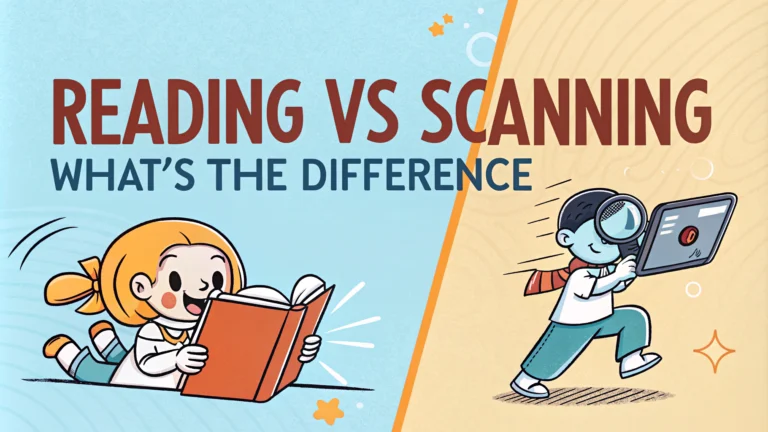Understanding the difference between **reading** and **scanning** helps you process information more efficiently. These two distinct approaches serve different purposes and knowing when to use each can save time while improving comprehension.
Reading requires **focused attention** and **deep understanding**, while scanning helps quickly locate specific information. Learning both skills matters for students, professionals, and anyone who needs to handle large amounts of text effectively.
How Reading and Scanning Differ
The main distinction lies in their **purpose** and **execution**. Reading involves:
- Complete text comprehension
- Sequential processing of information
- Higher retention rates
- Deeper engagement with the material
Scanning focuses on:
- Finding specific information quickly
- Identifying keywords and phrases
- Selective attention to relevant sections
- Quick overview of content structure
When to Use Each Method
Choose your approach based on your goals:
| Reading | Scanning |
|---|---|
| Novel reading | Finding phone numbers |
| Academic study | Locating specific facts |
| Complex documents | Menu selection |
Developing Better Reading Skills
Improve your reading efficiency through:
- **Active engagement** with the text
- **Note-taking** strategies
- **Vocabulary** development
- **Comprehension** exercises
> “Reading is to the mind what exercise is to the body.” – Joseph Addison
Enhancing Speed Reading Techniques
Build **speed reading** skills through proven methods:
- Practice eye movement exercises
- Use a finger or pen as a guide
- Reduce subvocalization
- Set reading speed goals
Track your progress by timing yourself while maintaining comprehension levels above 70%.
Digital Reading Strategies
Adapt reading methods for **digital content**:
- Adjust screen brightness and contrast
- Use reader mode when available
- Take regular breaks (20-20-20 rule)
- Implement text-to-speech tools
| Device | Recommended Settings |
|---|---|
| Computer | Dark mode, F.lux, larger fonts |
| Phone | Night mode, reading apps |
| E-reader | E-ink display, customized fonts |
Common Reading Mistakes to Avoid
Watch out for these **reading pitfalls**:
- Rushing without comprehension
- Skipping important context
- Not taking structured notes
- Reading without clear goals
> “Knowledge is of two kinds. We know a subject ourselves, or we know where we can find information upon it.” – Samuel Johnson
Practical Applications and Next Steps
Put your improved reading skills to work:
- Create a **reading schedule**
- Set specific learning objectives
- Join reading groups or study circles
- Practice daily reading exercises
Start with 15-minute daily practice sessions and gradually increase duration based on comfort and progress. Monitor improvements in both speed and comprehension through regular assessments.
Reading vs Scanning FAQs
Q: What’s the main difference between reading and scanning?
A: Reading involves detailed comprehension of text from start to finish, while scanning involves quickly moving your eyes over text to locate specific information or keywords.
Q: Which is faster – reading or scanning text?
A: Scanning is significantly faster than reading since it skips large portions of text. However, it results in lower comprehension of the overall content.
Q: When should I use scanning instead of reading?
A: Use scanning when:
- Looking up specific information like dates or numbers
- Finding relevant sections in a long document
- Reviewing familiar material
- Determining if a text is worth reading fully
Q: Does scanning affect reading comprehension?
A: Yes. Scanning provides only surface-level understanding. For full comprehension, detailed reading is necessary.
Q: What are the best techniques for speed reading?
A: Effective speed reading combines:
- Using a pointer or finger to guide eyes
- Reducing subvocalization
- Expanding visual field
- Practice with timed exercises
Q: How can I improve my scanning skills for academic texts?
A: Focus on understanding document structure, headings, bold text, and topic sentences. Practice identifying key terms and academic language patterns.
Q: What’s the average reading speed vs scanning speed?
A: Average reading speed is 200-400 words per minute, while scanning can reach 700+ words per minute.
Q: Is scanning text effective for digital content?
A: Yes, scanning is particularly effective for digital content due to:
- F-pattern reading on screens
- Hyperlinked text
- Chunked content
- Search functionality
Q: Can scanning improve overall reading efficiency?
A: Yes, combining scanning with detailed reading helps prioritize important sections and manages time better when handling large amounts of text.
Q: What’s the difference between scanning and skimming?
A: Scanning looks for specific information, while skimming provides a quick overview of the main ideas and structure of the text.
| Activity | Speed | Comprehension |
|---|---|---|
| Reading | 200-400 wpm | High |
| Scanning | 700+ wpm | Low |
| Skimming | 400-700 wpm | Medium |



















